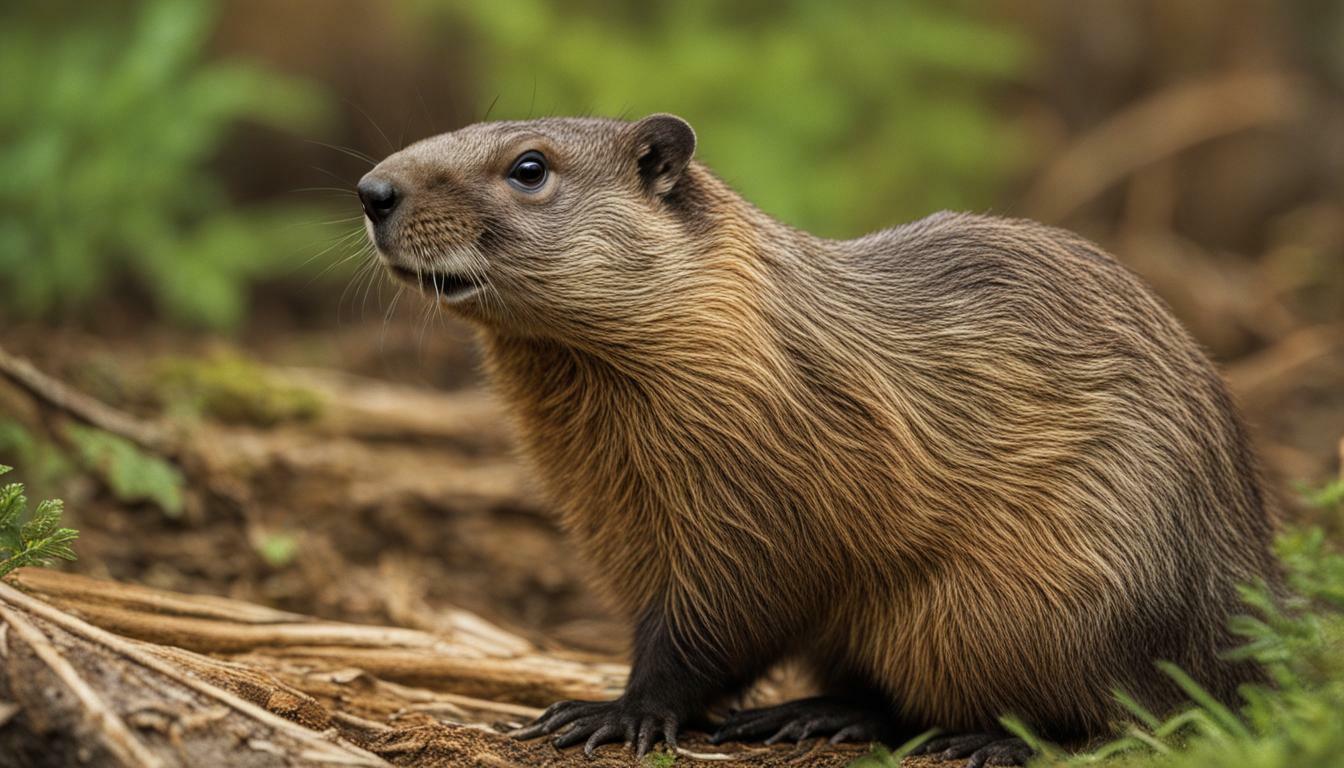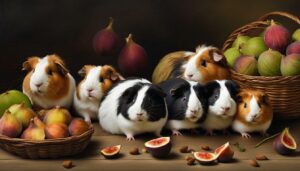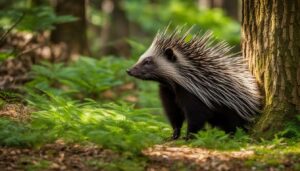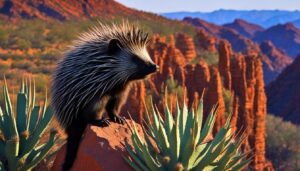Have you ever wondered if groundhogs and beavers are related? Let’s dive into the fascinating world of these creatures to unravel the mystery.
Key Takeaways:
- Groundhogs, also known as woodchucks, are more closely related to beavers and squirrels than to rats or pigs.
- Groundhogs have ever-growing front teeth, like beavers, and constantly gnaw to keep their teeth at the right length.
- While groundhogs are not helpful to humans, they are being used by scientists to study liver disease and hibernation.
- Groundhogs do not predict the length of winter, despite the popular tradition of Groundhog Day.
- Beavers and groundhogs have several differences, including their appearance, nesting habits, and behavior.
Groundhog vs Beaver – Similarities and Differences
When comparing groundhogs and beavers, it becomes apparent that there are both similarities and differences between these two species. Let’s take a closer look at some of the key aspects that distinguish them.
Physical Characteristics
One of the noticeable differences between groundhogs and beavers is their physical appearance. Beavers are larger, typically weighing between 35 to 70 pounds, while groundhogs are smaller, typically around 7 to 14 pounds. Additionally, beavers have flat, scaly tails, which they use to slap the water as a warning signal, while groundhogs have bushy tails, which serve as a form of communication.
Furthermore, their teeth differ as well. Beavers have yellow incisors that continuously grow throughout their lives, helping them gnaw through wood, while groundhogs have white front teeth that also grow constantly, allowing them to chew on plants.
Nesting Habits and Behavior
Beavers are known for their impressive engineering skills, as they build dams and lodges to create their habitats. They live in colonies and construct intricate structures to regulate water levels and provide protection. On the other hand, groundhogs are solitary animals that prefer to dig burrows in the ground, creating extensive tunnel systems for shelter and hibernation.
Moreover, their behavior differs as well. Beavers are primarily nocturnal, while groundhogs are diurnal, meaning they are active during the day. Beavers are herbivores, feeding on bark, twigs, and other vegetation, while groundhogs have a broader diet, including grasses, fruits, and even insects.
Summary
In summary, while groundhogs and beavers may look similar at first glance, there are distinct differences between them. Beavers are larger, have flat tails and yellow incisors, and live in colonies, while groundhogs are smaller, have bushy tails and white front teeth, and are solitary animals. They also differ in their nesting habits, with beavers building dams and lodges, and groundhogs creating burrows. Overall, although they share some similarities, groundhogs and beavers are separate species with unique characteristics and behaviors.
| Groundhogs | Beavers |
|---|---|
| Smaller size | Larger size |
| Bushy tail | Flat, scaly tail |
| White front teeth | Yellow incisors |
| Solitary | Live in colonies |
| Build burrows | Construct dams and lodges |
| Diurnal (active during the day) | Nocturnal (active at night) |
Physical Characteristics of Groundhogs and Beavers
Groundhogs and beavers have distinct physical characteristics that make them easily identifiable. While they may share some similarities, their differences are what set them apart. Let’s take a closer look at the physical characteristics of these fascinating creatures.
Groundhogs:
| Characteristics | Description |
|---|---|
| Size | Groundhogs are smaller in size compared to beavers. They typically measure around 20-27 inches in length and weigh between 4-14 pounds. |
| Tail | Groundhogs have bushy tails that are relatively shorter than those of beavers. Their tails serve as a communication tool, signaling danger to other groundhogs. |
| Teeth | Groundhogs have prominent white front teeth that constantly grow throughout their lives. They use these incisors for gnawing on plants and digging burrows. |
Beavers:
| Characteristics | Description |
|---|---|
| Size | Beavers are larger than groundhogs. They can reach lengths of 29-39 inches and weigh between 35-66 pounds. |
| Tail | Beavers have flat, paddle-like tails that are covered in scales. These tails help them navigate through water and can also be used to slap the surface, alerting others to danger. |
| Teeth | Beavers have distinctive yellow-orange incisors that are continuously growing. They use these powerful teeth to fell trees and construct their impressive dams and lodges. |
These physical differences reflect the unique adaptations that groundhogs and beavers have developed for their respective habitats and lifestyles. While they may belong to the same rodent family, their distinct characteristics make it clear that they are separate species with their own remarkable traits.
So, the next time you spot a groundhog or a beaver, take a moment to appreciate the physical features that make them so special. From the groundhog’s bushy tail and white front teeth to the beaver’s flat tail and yellow incisors, these creatures are truly remarkable examples of the diversity and wonder of the natural world.
Groundhog and Beaver Relationship to Other Animals
Groundhogs and beavers belong to the fascinating group of rodents, but how are they related to other creatures? Let’s explore their classification within the animal kingdom and their evolutionary relationships.
Both groundhogs and beavers are members of the order Rodentia, which consists of over 2,000 different species. This diverse group includes squirrels, rats, mice, and even capybaras, the largest rodents in the world. While groundhogs and beavers may share some similarities with other rodents, they have distinct characteristics that set them apart.
Groundhogs: A Unique Branch of Rodents
Groundhogs, also known as woodchucks, belong to the Marmotini tribe within the ground squirrel subfamily. They are part of the Sciuridae family, which includes squirrels, chipmunks, and prairie dogs. This makes groundhogs more closely related to these furry creatures than to rats or pigs.
Beavers, on the other hand, belong to the Castoridae family, making them the only living members of this family. They have a distinct evolutionary path, separate from the groundhog lineage. Beavers are known for their remarkable ability to modify their environments by building dams and creating wetlands.
Overall, while groundhogs and beavers may share a common classification as rodents, they each have their own unique branches within the rodent family tree. Understanding their relationship to other animals adds to the appreciation of their evolutionary history and their important roles in the ecosystems they inhabit.
| Groundhogs | Beavers |
|---|---|
| Belong to the ground squirrel subfamily | Belong to the only living species in the Castoridae family |
| Part of the Sciuridae family, along with squirrels, chipmunks, and prairie dogs | Known for their ability to modify environments by building dams and creating wetlands |
| Closely related to other members of the ground squirrel subfamily | Unique evolutionary branch within the rodent family tree |
Habitat and Nesting Habits of Groundhogs and Beavers
Understanding the habitat and nesting habits of groundhogs and beavers is key to appreciating their unique lifestyles. While these animals may appear similar at first glance, their preferences and behaviors differ significantly.
Groundhogs, also known as woodchucks, are solitary animals that prefer to live in open grassy areas, such as fields, meadows, and the edges of forests. They dig burrows in the ground, which can extend up to several feet deep and include multiple chambers for different purposes. These underground homes provide protection from predators and the elements, and groundhogs are known for their extensive tunneling systems.
On the other hand, beavers are well-known for their ability to alter their environment to create suitable habitats. They are found near bodies of water, such as rivers, streams, and ponds, and construct dams to create ponds that serve as their living spaces. Beavers build lodges made of branches, mud, and other materials near the water’s edge. These lodges have underwater entrances, providing safe access to their homes while protecting them from predators.
Here’s a comparison of the habitat and nesting habits of groundhogs and beavers:
| Groundhogs | Beavers | |
|---|---|---|
| Habitat | Open grassy areas | Near bodies of water |
| Nesting | Underground burrows with multiple chambers | Lodges made of branches and mud near water |
As seen from the table, groundhogs prefer open grassy areas and create intricate tunnel systems underground. Beavers, on the other hand, thrive near bodies of water and construct lodges near the water’s edge.
- Groundhogs prefer open grassy areas.
- Beavers are found near bodies of water.
- Groundhogs dig burrows in the ground.
- Beavers construct lodges made of branches and mud.
By understanding these distinct habitat and nesting habits, we gain a deeper appreciation for the natural adaptations and behaviors of groundhogs and beavers. While both animals have their unique ways of creating homes, they have successfully adapted to their respective environments.
Groundhogs: Misconceptions and Unexpected Benefits
Groundhogs, often known as woodchucks, have a few surprises up their sleeves that might change how you perceive them. Despite their cute and seemingly harmless appearance, they are not just simple rodents. In fact, groundhogs are more closely related to beavers and squirrels than to rats or pigs. These furry creatures belong to the sciuridae family, which includes many other rodents.
One surprising benefit of groundhogs is their contribution to scientific research. Scientists have been studying groundhogs to better understand liver disease and hibernation. These animals are particularly useful in liver research because their livers can regenerate, similar to how human livers are capable of some regenerative abilities. By studying groundhogs, scientists hope to gain insights into potential treatments for liver diseases in humans.
Another misconception about groundhogs is their association with predicting the length of winter. Contrary to popular belief, groundhogs do not possess any special ability to predict the weather. The tradition of Groundhog Day, where it is believed that the groundhog’s behavior on February 2nd can forecast the duration of winter, is purely a folklore tradition.
| Groundhogs | Beavers |
|---|---|
| Smaller in size | Larger in size |
| Bushy tails and white front teeth | Flat tails and yellow incisors |
| Solitary animals | Live in colonies |
While groundhogs and beavers may share some physical similarities, such as their semi-aquatic nature, there are several distinct differences between them. Beavers are larger in size, have flat tails, and yellow incisors, whereas groundhogs are smaller, have bushy tails, and white front teeth. Additionally, beavers live in colonies and construct complex dams and lodges, while groundhogs are solitary animals that burrow in the ground.
In a hypothetical fight between a groundhog and a beaver, the beaver would likely have the advantage due to its larger size and greater strength. However, it’s important to note that such fights rarely occur in nature, as groundhogs and beavers have different habitats and behavior patterns.
Groundhogs and Beavers in Popular Culture
Groundhogs and beavers have captured the imagination of people in various forms of popular culture. These fascinating creatures have been depicted in folklore, literature, movies, and even as mascots. Their unique characteristics and behaviors have made them iconic symbols in many societies.
In folklore, groundhogs are often associated with predictions and the changing of seasons. The tradition of Groundhog Day, celebrated on February 2nd, revolves around the belief that if a groundhog emerges from its burrow and sees its shadow, winter will continue for six more weeks. This tradition has been popularized through films and media, further solidifying the groundhog’s connection to seasonal predictions.
Beavers, on the other hand, are often portrayed as industrious and resourceful animals. Their ability to build intricate dams and lodges has made them a symbol of hard work and perseverance. Beavers have been featured in children’s stories and cartoons, often depicted as clever characters overcoming obstacles with their ingenuity and teamwork.
| Groundhogs in Culture | Beavers in Culture |
|---|---|
| The tradition of Groundhog Day | Depicted as industrious and resourceful |
| Representation in movies and media | Symbol of hard work and perseverance |
| Folklore and predictions | Featured in children’s stories and cartoons |
Whether it’s Punxsutawney Phil, the famous groundhog revered for his weather forecasting skills, or the beaver mascot of a sports team, these animals have woven their way into the fabric of our culture. Their presence in popular culture serves as a testament to the intrigue and fascination they inspire in people, and the enduring legacy of their unique characteristics.
Groundhog Day and Winter Predictions
Groundhog Day has become synonymous with predicting winter’s duration, but is there any truth behind this tradition? Let’s take a closer look at the relationship between groundhogs and winter predictions.
Contrary to popular belief, groundhogs or woodchucks do not possess any special ability to predict the length of winter. The tradition of Groundhog Day dates back to early European settlers in America who observed the behavior of hibernating animals, such as groundhogs, as they emerged from their burrows in early February. If the groundhog sees its shadow, it is believed that winter will last another six weeks. If it doesn’t, then spring will arrive early.
However, this prediction is not based on any scientific evidence and is purely a folk tradition. Groundhogs are not equipped with the instincts or biological mechanisms to accurately forecast the weather. Their emergence from hibernation is primarily determined by factors such as temperature and daylight, rather than the presence or absence of a shadow.
So, while Groundhog Day continues to capture the imagination of many, it is important to remember that it is simply a fun and lighthearted tradition, rather than a reliable indicator of winter’s duration. Enjoy the festivities and the folklore surrounding these charming creatures, but don’t rely on a groundhog to tell you when spring will arrive.
| Fact | Groundhogs | Beavers |
|---|---|---|
| Appearance | Smaller, bushy tail, white front teeth | Larger, flat tail, yellow incisors |
| Nesting Habits | Solitary animals, burrowers | Live in colonies, construct elaborate lodges and dams |
| Behavior | Herbivorous, prefer to gnaw on green plants | Herbivorous, fell trees and manipulate their environment |
In conclusion, while groundhogs and beavers may share some similarities in appearance, they are distinct creatures with different habits and characteristics. Groundhogs are not weather forecasters, and their emergence or retreat into their burrows during Groundhog Day does not determine the length of winter. Enjoy the folklore surrounding these fascinating animals, and let nature take its course when it comes to seasonal changes.
Groundhog vs Beaver: Who Would Win in a Fight?
In a showdown between a groundhog and a beaver, which creature would come out on top? Let’s take a closer look at the physical attributes and behaviors of these two animals to determine their fighting capabilities.
Size and Strength: Beavers are larger and more robust than groundhogs, weighing up to 60 pounds compared to the groundhog’s average weight of 12-15 pounds. This size advantage gives beavers a significant edge in a fight, as they have more muscle mass and power behind their movements.
Teeth and Tail: Both beavers and groundhogs have unique dental features that aid them in their daily activities. Beavers possess large, sharp incisors that they use to fell trees and build dams, while groundhogs have strong front teeth that continuously grow, enabling them to gnaw on plants. In a confrontation, the beaver’s powerful teeth could inflict more damage, potentially giving it an advantage over the groundhog. Additionally, beavers have flat, leathery tails which they use for swimming and communication, whereas groundhogs have bushy tails that are mainly used for balance.
Social Behavior: Beavers are highly social creatures that live in colonies, whereas groundhogs are solitary animals. This difference in behavior could play a role in a fight, as beavers might have experience working together and coordinating their movements. Groundhogs, on the other hand, are more accustomed to fending for themselves and surviving on their own.
Conclusion:
In a physical confrontation, the larger size, greater strength, and potentially more coordinated movements of the beaver would likely give it the upper hand in a fight against a groundhog. However, it’s important to remember that animals typically avoid unnecessary conflicts and prioritize their own survival rather than engaging in aggressive encounters. So, while it’s interesting to imagine a battle between a groundhog and a beaver, it’s unlikely to occur in reality.
| Groundhog | Beaver |
|---|---|
| Smaller size (12-15 pounds) | Larger size (up to 60 pounds) |
| Bushy tail | Flat, leathery tail |
| White front teeth | Yellow incisors |
| Solitary animals | Live in colonies |
The Distinct Differences Between Groundhogs and Beavers
While groundhogs and beavers may share some similarities, their differences are significant enough to establish their distinct identities. From their appearances to their nesting habits and behavior, these two creatures have several contrasting features that set them apart.
Firstly, in terms of size, beavers are generally larger than groundhogs. Beavers can grow up to 3 to 4 feet in length and can weigh around 40 to 60 pounds. On the other hand, groundhogs, also known as woodchucks, are smaller, measuring about 16 to 26 inches in length and weighing between 4 to 14 pounds.
Another noticeable difference is their tails. Beavers have distinctly flat, paddle-like tails, which they use as a rudder while swimming and as a warning signal to other beavers. In contrast, groundhogs have bushy tails that are not as flattened. These tails serve as an added balance while they are on land, but they do not use them for swimming purposes.
Additionally, their teeth also differ. Beavers have yellow-colored incisors, while groundhogs have white front teeth. Both animals have ever-growing teeth and gnaw on wood, but beavers are known for their remarkable ability to fell trees and build dams and lodges, while groundhogs primarily focus on gnawing on green plants and digging burrows in the ground.
| Groundhogs | Beavers |
|---|---|
| Smaller in size | Larger in size |
| Bushy tails | Flat, paddle-like tails |
| White front teeth | Yellow incisors |
| Solitary animals | Live in colonies |
In terms of behavior, beavers are known for their complex social structures and colonies. They live in family groups and work together to construct impressive dams and lodges. Groundhogs, on the other hand, are solitary animals that prefer to live alone in burrows they dig underground.
Overall, while groundhogs and beavers may look similar at first glance, their distinct differences in appearance, nesting habits, and behavior reveal that they are not closely related. These unique characteristics highlight the fascinating diversity found within the animal kingdom.
Conclusion
After exploring the similarities and differences between groundhogs and beavers, it becomes evident that these two animals are not closely related, despite their superficial resemblances. Groundhogs, also known as woodchucks, share more similarities with beavers and squirrels than with rats or pigs. Like beavers, they have ever-growing front teeth that constantly require gnawing to keep them at the right length.
While beavers use their gnawing abilities to construct dams and manipulate timber, groundhogs prefer to gnaw on green plants. Unlike beavers, groundhogs do not have the capability to move timber or alter their environment in the same way. This distinction in behavior and habitat preferences sets them apart from each other.
Furthermore, groundhogs, also called woodchucks, have become invaluable to scientific research. These animals are currently being used by scientists to study liver disease and hibernation, providing important insights into these areas of study. However, it’s important to note that groundhogs do not possess the ability to predict the length of winter, despite the popular tradition of Groundhog Day.
When comparing the physical characteristics of groundhogs and beavers, several differences become apparent. Beavers are larger in size and have flat tails and yellow incisors, whereas groundhogs are smaller and have bushy tails and white front teeth. Additionally, beavers live in colonies and construct elaborate dams and lodges, while groundhogs are solitary animals that create burrows for shelter.
In a hypothetical fight between a groundhog and a beaver, the beaver would likely emerge victorious due to its larger size and greater strength. However, it’s important to remember that such a scenario is purely speculative, as these animals do not typically interact or engage in aggressive encounters.
Overall, while groundhogs and beavers may share some physical similarities, they have distinct differences that set them apart. Their contrasting behaviors, nesting habits, and physical characteristics clearly demonstrate that they are not closely related. By understanding these differences, we can gain a deeper appreciation for the uniqueness of each animal and the diverse ecosystems they inhabit.
FAQ
Are groundhogs and beavers closely related?
No, groundhogs and beavers are not closely related. While they may look similar, they have distinct differences and belong to different animal families.
What are the similarities and differences between groundhogs and beavers?
Groundhogs and beavers share some similarities in their gnawing behavior and teeth structure. However, they differ in appearance, nesting habits, and behavior.
How do groundhogs and beavers differ in their physical characteristics?
Groundhogs are smaller, have bushy tails, and white front teeth, while beavers are larger, have flat tails, and yellow incisors. They have different body structures and teeth.
Are groundhogs and beavers classified as rodents?
Yes, both groundhogs and beavers belong to the order Rodentia and are considered rodents. However, they are not closely related to rats or pigs.
What are the habitat and nesting habits of groundhogs and beavers?
Groundhogs prefer to live in burrows on land, while beavers construct dams and lodges in bodies of water. They have different preferences and behaviors when it comes to their habitats and nesting.
Do groundhogs predict the length of winter like in Groundhog Day?
No, groundhogs do not possess the ability to predict the length of winter. Their behavior on Groundhog Day is purely symbolic and not based on scientific accuracy.
Who would win in a fight between a groundhog and a beaver?
In a fight, a beaver would likely win due to its larger size and greater strength compared to a groundhog.
What are the distinct differences between groundhogs and beavers?
Groundhogs and beavers have differences in appearance, nesting habits, behavior, and other characteristics. They are distinct species with separate evolutionary paths.




